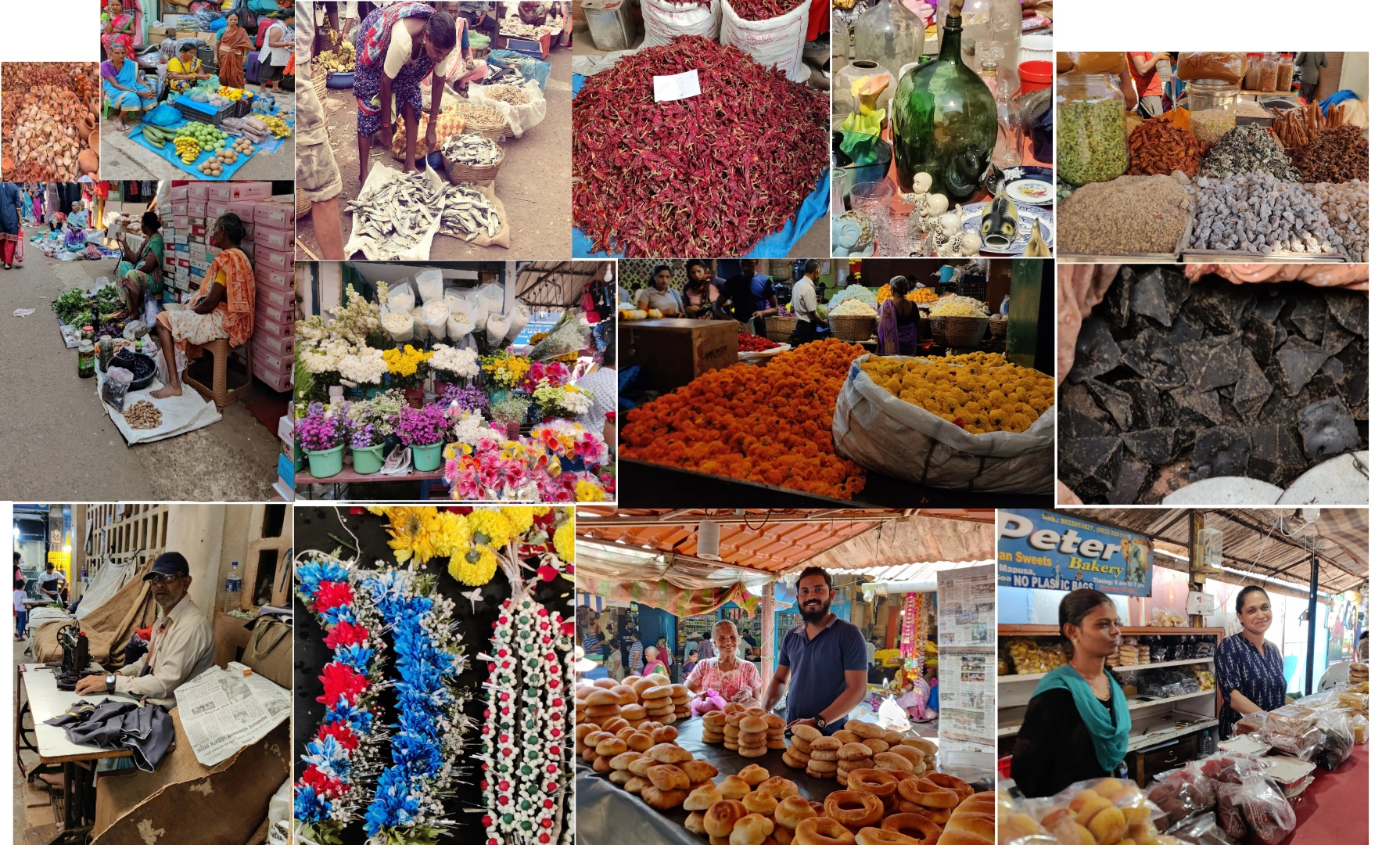
If it’s a Friday in Goa, all roads lead to Mapusa. The town’s history is deeply tied to its role as a thriving trade hub, once sustained by the ancient Mapusa River, which carried goods far and wide. Even today, its bustling market overflows with Goan delights—fragrant spices, beans, pickles, groceries, and sweetmeats, alongside cane and coconut artefacts, local vegetables, and seasonal fruits, from Moira bananas to bimblis and red spinach.
During the Portuguese era, the city was known as Mapuçá and functioned as a key administrative centre for Bardez Taluka. Its market was also famous for its grand cattle fair, where breeders from the ghats journeyed miles with their cows, bulls, and buffaloes—crossing rivers, hills, and forests—to strike a fair bargain in Mapusa. The effort and risk were always worth the reward.
Over time, the Mapusa market grew into more than just a trading hub—it became a vibrant social catalyst. Casual encounters between buyers and sellers often blossomed into lifelong friendships, while the Raibaris, the semi-professional marriage brokers, found plenty of work amid the lively bustle. Many Goan couples fondly trace the beginnings of their marital bliss to meetings arranged here, proudly acknowledging the market’s role in their happiness.
The name Mapusa traces back to the word Mahapasaita, where maha means big and pasaita refers to land granted to an administrative officer in return for services rendered. Finding the word too cumbersome, the Portuguese first simplified it to Mabussa and later to Mapuçá. After Goa’s merger with India in 1961, it became Mapusa, as English does not use diacritical marks.
Another legend links the name to its bustling marketplace. In earlier days, Mapusa was a vast open bazaar, especially for grain and cereals. Each time a hollow wooden measure, or maap in Konkani, was filled and emptied, the shop assistant would call out the sale in a loud, throaty voice while the cashier noted it down. From the countless measures bought and sold—maap-sa—the town, it is said, earned both its name and its enduring reputation for trade.
The modern avatar of the traditional bazaar was constructed in 1960. Expansive and lively, it blends quaint brick-and-mortar shops with winding lanes of stalls, spacious warehouses, and rows of vendors squatting by the roadside with their colourful wares. The market is an assault on the senses, its air rich with aromas—spicy, tangy, and exotic. Fragrant spices mingle with the scent of dried fish, while the eye is drawn to piles of cabbage, red peppers, limes, apples, and oranges. Adding to the charm are the Lamani women, gracefully selling mirrored blouses, skirts, and assorted bric-a-brac.
Much of the produce here is grown in fields in neighbouring villages, where old and young women arrive with a small square of cloth piled high with home-grown vegetables, wild berries, herbs, and other produce. The spice vendors tempt with aromatic treasures—colourful dhoop sticks for cleansing auras and spaces, foot-long curls of cinnamon, local bay leaves, cardamom so fragrant it takes your breath away, and richly blended curry powders.
Further along, stalls burst with horticultural blooms—vivid gerberas, delicate carnations, flamboyant lilies, and plump, fragrant tuberoses. Yet it is the local flowers that truly enchant: intricately woven garlands for deities, and venis for the hair, threaded with metallic strands by women deftly working with long, gleaming needles. Surrounded by towering baskets of marigolds, asters, roses, and tuberoses, they create fragrant little works of art—orange and golden marigolds, creamy-white and green tuberoses, crimson roses, snowy pompoms of asters, all woven into dazzling patterns.
The bakery section is equally irresistible. Simonia is famed for its bebinca and biscuits, while Pascoal, a tiny cash-only stall, draws eager crowds that quickly empty its shelves of sweetmeats. From doce, bol, and dodol to coconut cakes, batika, and savoury coconut treats, the selection is endless. Each bite carries the signature of local tradition—jaggery cut into little diamonds, fragrant coconut, rich coconut milk, and soft channa dal—flavours that linger long after the market stroll ends.
At St. Peter’s Bakery, mounds of freshly baked Goan bread are stacked high on large wooden tables, their aroma filling the air. Alongside, Goan nibbles tempt the passer-by—soft, spongy, and an assortment of savoury snacks. The breads themselves come in delightful variety, differing in texture, chew, and shape: crusty baguette-style boules, chewy local poee perfect for dipping into a fiery vindaloo, as well as rolls and loaves of every kind.
Nearby, some charming vintage stalls draw the curious with their trove of old glassware, ceramic jars, antique Portuguese blue pottery, and timeworn vinegar and pickle jars that whisper of another era. A lively avenue of tailors sits in neat rows, needles flying as sewing machines buzz in unison. And as you stroll further, rows of liquor shops beckon with their colourful displays of fine spirits and liqueurs, each bottle promising its own story of indulgence. Friday market in Mapusa is truly a celebration of the local spirit—a day for farmers and neighbourhood ladies who bring in the fruits of their labour. There is a special joy in buying produce that has been grown with care and love in someone’s field, offered to you with dignity, grace, and pride. Every stall tells a story of effort and tradition, making each purchase more than a transaction—it is a connection to the land and its people.